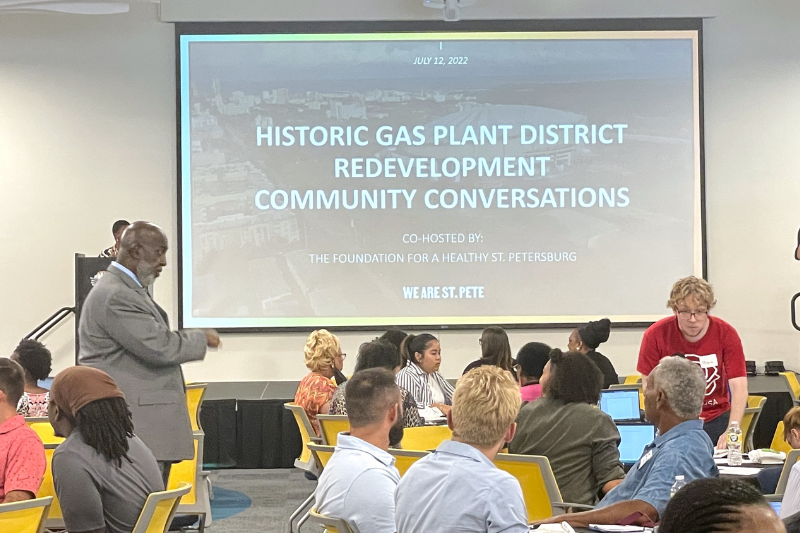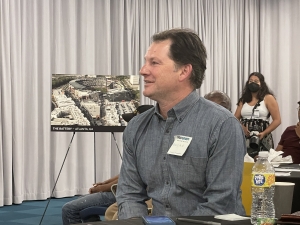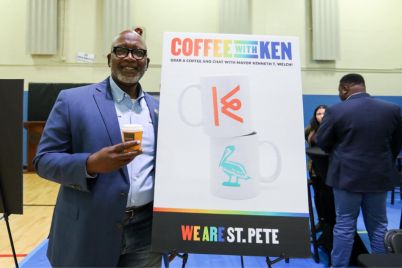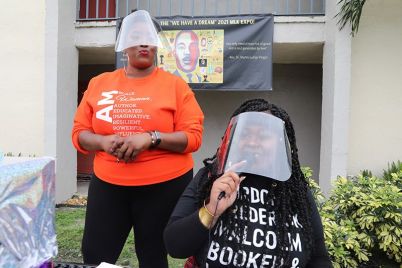The first of three community conversations was held Tuesday, July 12, at the Foundation for a Healthy St. Petersburg. These conversations will allow attendees to provide feedback on priorities for redeveloping the historic Gas Plant District.
BY SKYLA LUCKEY, Staff Writer
ST. PETERSBURG — Skyrocketing rent prices and years of unfulfilled promises by city officials have caused mixed opinions from St. Pete residents about economic security and what will come of the historic Gas Plant site that Tropicana Field, surrounded by a giant parking lot, sits atop.
About 200 residents plus city officials, including Mayor Ken Welch and Deputy Mayor Stephanie Owens, gathered for the first of three historic Gas Plant District redevelopment community conversations at the Foundation for a Healthy St. Petersburg Tuesday evening.
The 86 acres were once home to the Gas Plant district founded in 1890 as “Cooper’s Quarters.” As the second oldest Black neighborhood in St. Pete, the name was eventually changed to match the two large gas cylinders at the location.
Mayor Ken Welch announced on June 29 that he was issuing a new Request for Proposals (RFP) for the Gas Plant District redevelopment site because the environment has changed since the initial RFP was issued in July of 2020. Although he was impressed by the efforts of the two finalists in the old RFP process — Sugar Hill Community Partners and Midtown Development — he believed it needed some updating.
The mayor cited the need for more affordable and workforce housing and less office space along with the need for intentional equity and equitable development highlighted by the city’s Disparity Study and the Structural Racism report, which were completed after the issuance of the initial RFP.
City employees, Habitat for Humanity officials, and Green Book of Tampa Bay CEO Hillary Van Dyke shared presentations about business opportunities, affordable housing, and potential community events at the future redevelopment site at Tuesday evening’s discussion. Community members shared their input, too.

About 200 residents plus city officials, including Mayor Ken Welch and Deputy Mayor Stephanie Owens, gathered for the first of three Gas Plant District redevelopment community conversations at the Foundation for a Healthy St. Petersburg on Tuesday, July 12.
These presentations may have felt like déjà vu to some residents. During the 1970s and early 1980s, city officials promoted economic stability to Gas Plant residents that lived, worked, and played there.
The city’s plan to provide jobs and infrastructure to the area took a 180-degree turn when the final plan outlined a Major League Baseball stadium. The stadium resulted in demolishing Black-owned businesses, homes, churches, and schools, dislocating many Black families and erasing part of the city’s history.
Forty-three years later, the City of St. Pete has the chance to rectify an untenable wrong. Welch, who took office in January, told The Weekly Challenger Tuesday evening that there is a general concern by folks being displaced by progress.
“We’ve seen it happen before, and we’re seeing it now due to a number of factors: folks coming down from other parts of the country who have cash to spend for properties, and corporations doing the same,” Welch said. “So I understand, but what we have to do is be intentional by supporting home ownership with things like affordable housing.”
Welch pointed south on 34th Street toward Skyway Lofts, an affordable housing complex, showing that the city has already begun moving to support low-income residents. He said the city plans to continue that with inclusivity for the redevelopment of the Tropicana site.
Attendees sat at tables with a moderator as they discussed concerns and shared what they would like to see from the redevelopment. The moderator at each table recorded residents’ input for the city to review.
Some residents want to see opportunities for the youth, jobs that provide wages making St. Pete affordable to live in, and better public transportation. A few said they wanted the stadium gone, while others said they wanted it to stay, such as Leon Jackson, the last surviving member of the Courageous 12. Jackson said he grew up in the Gas Plant area.
Brian Caper, the City of St. Petersburg’s economic development manager, presented a slideshow of baseball stadium sites smaller than 86 acres, such as the Chicago Cubs’ Wrigley Field, which seems to bring communities together on non-game days with fun family events outside the stadium and sometimes in.
“Do you see how the stadium just blends in with the housing developments and businesses around the stadium,” Caper asked as he displayed pictures of Major League Baseball stadiums not sitting in a sea of parking spaces.
Community activist, Carla Bristol, said she’s not skeptical about the positive changes city leaders are discussing.
“I have the compassion of knowing that the person who is leading and in the driver’s seat (Welch) has actually been impacted by this [Gas Plant demolition],” Bristol said. “So, he and his family are part of this displacement that we are trying to address.”
Mayor Welch’s grandfather’s business and family home were razed to build the stadium.
The city has two more community conversations scheduled if you want to attend. Click here for more information on the upcoming meetings and to follow the city’s redevelopment timeline.
Welch said he would have a developer chosen by the end of December.









